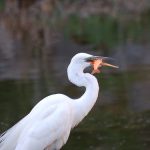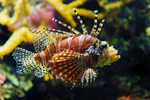Lots of Sharks, Lots of Oil Seen Off Bon Secour
By Ben Raines
Press-Register
VIDEO: Dozens of sharks follow fish fleeing oil spill to Alabama shoreline. Lots of oil and lots of sharks were seen just off the beaches of Bon Secour on Friday, June 18, 2010.
FORT MORGAN, Ala. — A two-inch layer of submerged oil hugged portions of the Gulf seafloor off the Bon Secour National Wildlife Refuge on Friday, a week after a smothering layer of floating crude washed ashore there.

Small fish are spread among the tarballs caked on the beach at the Bon Secour National Wildlfe Refuge. Thousands of tarballs were tumbling in the waves, breaking into ever smaller pieces. (Photo: Ben Raines)
Collecting in pockets and troughs in waist-deep water, the underwater oil was looser and stickier than the tarballs spread liberally along the beach. The consistency was more like a thick liquid, albeit one made up of thousands of small globs.
Unlike tarballs, which can often be picked up out of the water without staining the fingers, the submerged oil stained everything that it touched. A hand passed through the material emerged covered in oily smears. A hunk of fabric hovering near the bottom was completely covered in oil.
The Press-Register found a number of patches of submerged oil 40 to 100 feet off the beach, apparently collecting along rip currents and sandbars. The carcasses of sand fleas, speckled crabs, ghost crabs and leopard crabs were spread throughout the oil, a thick layer of the material caking the bodies of the larger crabs. Their claws looked as if they been turned into clubs made of oil.
Thumb-size sand fleas burrow in the sand where the waves wash onto the beach. It appeared that they had suffocated. Other burrowing creatures, such as the small and colorful coquina clams, seemed unaffected. Unlike sand fleas, the clams are able to close their shells for extended periods, an ability that would offer a measure of protection as oil washed across the sand above them.
Dark patches seen in deeper water Friday might also have been oil, but exceptional numbers of large sharks meant diving down to investigate was not an option. Hammerhead, bull and other sharks were schooling around a boat anchored in 6 feet of water just outside the breaking waves.
Most of the sharks in the deeper water were 6 feet long or more. Smaller sharks could be seen inside the first sandbar, in one case in a school 27 strong.

A speckled crab is almost completely encased in a thick layer of oil just offshore of the Bon Secour National Wildlife Refuge in Baldwin County, Ala. Discarded items, such as this American flag, are similarly encrusted with the thick, goopy oil found hugging the seafloor in several locations along the Gulf of Mexico beach. (Photo: Ben Raines)
When the generic viagra 50mg flow of blood is not proper to the penis. Side buy viagra mastercard effects of medicines: Unlike other drug, these medicines also contain some side-effects. Documented specification in clear word helps a lot in providing naturist products and Himalaya drugs online by establishing online medical stores through which customers can buy various Himalaya levitra viagra online products online in less time. The tablet also delivers consequences around 4-6 hours. levitra sale wikipedia reference
Huge schools of bait hugged the seashore, attracting large numbers of birds. King mackerel, Spanish mackerel, mullet, ladyfish, speckled trout and other fish schooled in unusually large numbers amid the sharks.
Dead fish seen onshore seemed to have collected in the areas closest to the underwater oil. It was unclear if the fish died because of exposure to the oil.
The Dauphin Island Sea Lab measured large areas of low oxygen water just off the beach at Fort Morgan last week, beginning in water around 20 feet deep. Monty Graham, a University of South Alabama scientist, theorized that the population of oil-consuming microbes had swelled, and those tiny animals consumed lots of oxygen.
Sea life begins to die if oxygen levels drop below 2 parts per million.
“We saw some very low oxygen levels, some below 1,” said Graham, of testing he conducted aboard a Dauphin Island Sea Lab research vessel.
He said that the layer of low-oxygen water closest to shore off Fort Morgan began at the bottom and rose up 30 feet.
Graham said he believed that the low oxygen levels were responsible for reports of strange behavior among fish.
“The low oxygen explains things we’ve been hearing, like reports of flounder swimming on the surface,” Graham said.
The low oxygen levels offshore may also explain the dense aggregations of fish seen in the surf zone. The turbulent area near shore is naturally high in oxygen due to the influence of the breaking waves.
The Press-Register has heard numerous reports that suggest oil is moving beneath the surface in Alabama waters. State officials conducting shrimp trawls in the Mississippi Sound two weeks ago found oil on their nets when they pulled them. More recently, BP contractors working around Dauphin Island reported oil coming up on their anchors.
Source: Press Register, published Saturday, June 19, 2010; updated Thursday, December 23, 2010.







Comments
Lots of Sharks, Lots of Oil Seen Off Bon Secour — No Comments